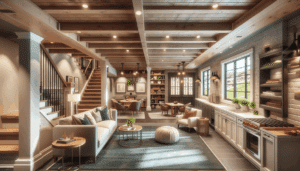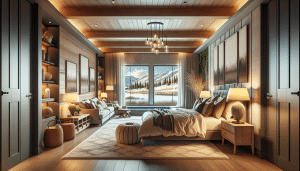Basement Bedrooms can feel like a secret — cozy, quiet, and somehow more private than upstairs. But they can also feel cold, damp, and a little… cave-like. If you live in Salt Lake County, Davis County, or Utah County, you’ve probably thought about turning that underused space into a comfortable sleeping area. You know what? With a few smart moves (and a little help from pros), you can make a basement bedroom that’s warm, bright, and code-compliant — a room people actually want to sleep in.
Contents
- 1 Start with dry — because comfort begins with moisture control
- 2 Light it up — so everyone forgets they’re below grade
- 3 Temperature and sound — making it cozy and quiet
- 4 Finishes that say “bedroom,” not “workshop”
- 5 Safety and legality — yes, it’s a little boring, but important
- 6 Personal touches — because this is a bedroom, not a demo
- 7 Ready to make it real?
Start with dry — because comfort begins with moisture control
Here’s the thing: most basement problems begin with water. Even a little humidity will ruin drywall, carpet, and sleep. So before you pick paint colors or buy a mattress, make sure the space is dry.
Check the perimeter for cracks, watch for efflorescence (white powder on concrete), and consider a sump pump if your neighborhood sees spring runoff. French drain systems and exterior waterproofing are common solutions here in the Wasatch Front. Inside, a quality dehumidifier (look for brands like Aprilaire or Frigidaire) set to 45–50% will keep the room comfortable without drying it out like a desert.
Insulation matters, too. Rigid foam board on foundation walls plus a layer of drywall creates a warm interior surface and reduces cold spots. But don’t skip the vapor control: you want walls that stay warm and dry, not trapped and moldy. It’s a little contradictory — we want insulation to seal, and yet we need the space to breathe — so balance is key. Let me explain: seal the big leaks, but provide controlled ventilation and a dehumidifier to manage moisture.
Light it up — so everyone forgets they’re below grade
Basements are naturally darker. But you can trick the eye and the spirit. Natural light through egress Windows changes everything. Not only do they meet safety rules for bedrooms, they bring in daylight that lifts mood. Check with your local building department in Salt Lake, Davis, or Utah County — egress size and placement matters.
Layer lighting like a pro: ambient (recessed LEDs), task (bedside lamps), and accent (wall sconces or a strip behind shelving). Warm LEDs, 2700–3000K, feel like home. Smart switches from Lutron or a Philips Hue starter kit let you set scenes — dim for reading, bright for cleaning. Recessed cans with baffles reduce glare; pendant lights add personality.
You can also use solar tubes or light wells at times when window installation isn’t possible. They’re a bit of a trick, but they work. And honestly, once a room has good lighting, people act like it’s twice as big.
Temperature and sound — making it cozy and quiet
Basement bedrooms can be cold in winter and a bit stuffy in summer. Tying the space into your home’s HVAC is ideal, but it’s not always necessary. Mini-split heat pumps (Mitsubishi, Fujitsu) are popular in Utah — they heat and cool efficiently and avoid ductwork headaches. Radiant floor heating feels luxurious; it’s a small investment that pays off on cold mornings.
Soundproofing matters for sleep — especially if the TV’s loud upstairs or the laundry runs at odd hours. Use resilient channel or Green Glue between framing and drywall to reduce sound transfer. A thick carpet with a dense pad helps, too. It’s funny: basements are quieter because they’re below grade, but they can also carry noise oddly if you don’t treat the floors and ceilings.
Finishes that say “bedroom,” not “workshop”
You can spend a little or a lot here. The goal is a bedroom feel without turning the space into a completely different house.
- Walls: Standard drywall with a knockdown texture is simple and clean. Consider moisture-resistant drywall on the lower portions if humidity’s a concern.
- Ceiling: A drywalled ceiling looks polished; an acoustical drop ceiling offers easy access to ducts and pipes. Both are fine — pick what suits your lifestyle.
- Floors: Luxury vinyl plank (Coretec, Shaw) is a favorite — it’s waterproof, warm underfoot, and looks like wood. If you want plush comfort, go with carpet and a good pad.
Paint color matters more than most people realize. Lighter hues open up a room, but don’t be scared of color — a warm greige or soft sage can feel snug, like a hug after a long day. Add trim and built-in shelving to give the room character. Storage is crucial in basements — built-in dressers or closet organizers keep clutter out of sight and help the room feel adult and intentional.
Safety and legality — yes, it’s a little boring, but important
Don’t skip permits. Bedrooms require egress windows, proper smoke and CO detectors, and sometimes specific ceiling heights. Each county — Salt Lake, Davis, Utah — has its own rubric, and if you skip the paperwork, you may have trouble selling the house later or even get fined. Utah Basement Finishing handles permits all the time; we know the inspectors and the local quirks.
Also, wire the room correctly. Hardwired smoke detectors that are interconnected are now standard in many areas. Ground-fault circuit interrupter (GFCI) outlets near any water source are a must. In short: do it right now, so you don’t have to fix it under stress later.
Personal touches — because this is a bedroom, not a demo
Finally, make it yours. Soft sheets, layered blankets, and a mattress that fits your sleep style will make all the technical work pay off. Add blackout curtains for light control; a small ceiling fan for airflow in warmer months; a bedside shelf for a good book (and a phone charger).
Here are a few quick ideas that make a big difference:
- Scale furniture: Choose pieces that fit, not overwhelm. Basements can feel smaller; small furniture helps balance that.
- Closet feel: Good lighting and adjustable shelving make storage useful, not just decorative.
- Local touches: A framed map of the Wasatch Range or a photo from Antelope Island ties the room to where you live.
Seasonal layers are useful too. In Utah winters, extra throws and a humidifier can help with dry air; come summer, breathable sheets and a small dehumidifier keep things pleasant. Little contradictions pop up — you want insulation and airflow at once — but handled right, they create balance rather than problems.
Ready to make it real?
If you live in Salt Lake County, Davis County, or Utah County and want a basement bedroom that’s safe, cozy, and stylish, we’re here to help. Utah Basement Finishing handles everything from waterproofing and permits to lighting, HVAC tie-ins, and final trim. Give us a call at 801-515-3473 — or Request a Free Quote — and we’ll walk you through the process, answer your questions, and give you a plan that fits your home and budget.



